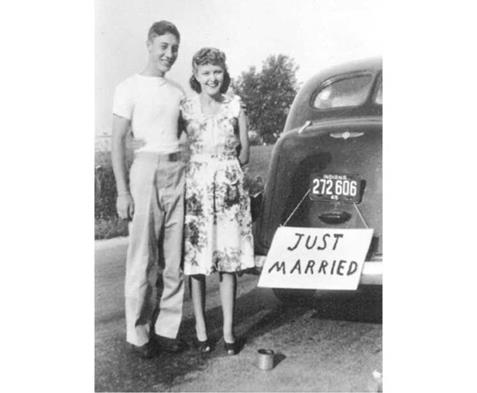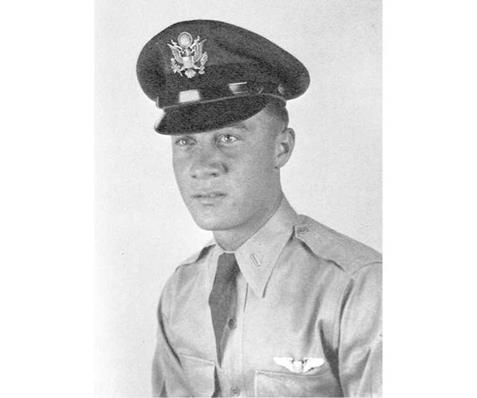JOINING THE AIR FORCE
While at Mitchell High School, Grissom completed a year of pre-cadet training in the U. S. Army Air Corps, which he found most enjoyable. By this time his interest in aviation had taken a deeper hold, and he took on summer casual work in order to pay for brief flights in barnstorming airplanes at nearby Bedford airport, Indiana. A local attorney who owned a small aircraft would often take him on flights for a one dollar fee and taught him the basics of flying.
Grissom picked up the nickname ‘Gus’ during a card game when someone saw the abbreviated name on an upside-down score card and mistakenly translated it to “Gus.” Before long, Grissom’s friends also began calling him Gus, and it stuck. But he will always be known as Virgil to the people in his hometown in Mitchell.
World War II broke out while Grissom was still in high school, and he was eager to enlist upon graduation. On 8 August 1944 – Betty’s seventeenth birthday – he was inducted into the Army Air Forces at Fort Benjamin Harrison, with the expressed desire of becoming a pilot. He was subsequently ordered to Sheppard Air Force Base (AFB) in Wichita Falls, Texas, for five weeks of basic training. Then he was assigned to Brooks Field in San Antonio, where, to his extreme disappointment, he spent his days behind a desk as a lowly clerk.
Grissom took some short leave and on 6 July 1945, while still in his teens, he and Betty were married in the First Baptist Church in Mitchell. He then returned to the Air Force while Betty remained in Mitchell, working at the Reliance Manufacturing Company making shirts for the Navy. Soon after, Japan capitulated and the Second
|
Newlyweds Gus and Betty Grissom. (Photo: World Book Science Service) |
World War came to an end. Dispirited with the lack of flight training within the Air Force, Grissom left the service in November 1945 with the rank of corporal and took up a job fitting out school buses in Mitchell’s Carpenter Body Works, but it was the kind of mundane and repetitive work he hated. Deciding to become a mechanical engineering student, he enrolled at Purdue University, Indiana under the G. I. Bill in September 1946. He and Betty took a small apartment near the campus, and while Betty worked as a long-distance telephone operator to help pay the bills, he found some after-class work as a short-order cook “frying hamburgers for 30 hours a week.”6 Fortunately he found his studies absorbing and to his liking, and he graduated with his bachelor of science degree in February 1950.
He had contemplated entering private industry at this stage of his life, but when the Korean war broke out Grissom decided to re-enlist in the Air Force and was assigned to Randolph AFB, Texas as an aviation cadet. On 16 May 1950, he and Betty welcomed their son Scott into the world. In September Grissom graduated from basic flight training and was sent to Williams AFB in Phoenix, Arizona for more advanced training. He received his wings and was commissioned a 2nd lieutenant in March 1951. In December of that year he was shipped off to the conflict in Korea to fly North American F-86 Sabre jets with the 334th Fighter Interceptor Squadron.
|
2nd Lieutenant Grissom after receiving his wings in March 1951. (Photo: Carl L. Chappell) |
Six months after his arrival in South Korea Grissom had reached the 100-mission mark and was promoted to 1st lieutenant. He was eager to fly another 25 missions, but his request for an extension was refused and he returned home having earned a Distinguished Flying Cross and the Air Medal with cluster. After a period in Flight Instructor School he was designated as a flight instructor at Bryan AFB, Texas. On 30 December 1954 he and Betty completed their family with the birth of second son, Mark. The following year Grissom was assigned a place at the Air Force Institute of Technology at Wright-Patterson AFB, Ohio, to study aeronautical engineering. He then won an assignment to the prestigious and highly prized Test Pilot School at Edwards AFB, California, checking out advanced-design fighter airplanes.












